Asparagus Nutrition Facts
Asparagus, a delicate shoot vegetable, emerges from underground rhizomes and is cherished as a flavorful spring delicacy. Its culinary appeal was recognized by ancient Greeks and Romans, who esteemed its delicateness. Among the oldest recorded vegetables, it is believed to have originated in coastal areas of the eastern Mediterranean and Asia Minor regions.
Botanically, asparagus is an herbaceous perennial plant categorized within the Asparagaceae family. It shares close botanical ties with plants in the Liliaceae family, such as onion, garlic, tulip, and daffodil. Scientific name: A. officinalis. This spear-like vegetable is cultivated extensively as a significant commercial crop in China, Europe, Peru, Australia, and the USA.
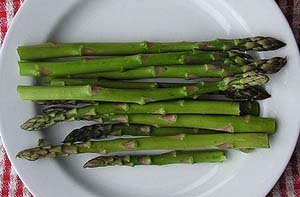 |
| Asparagus spears. (Photo courtesy: muffet) |
Asparagus crowns are typically planted in early spring, developing into tall, branched stems adorned with delicate, fern-like green needles (phylloclades), imparting a feathery look to the entire plant. Alternatively, the fresh crop can be established either through direct seeding or transplanting 10-12 week-old seedlings.
Once fully grown, the plant reaches approximately 5 feet in height. From the extensive matted root systems, young scaly edible spears emerge, ready for harvesting by early spring.
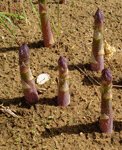 |
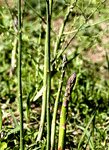 |
| Young shoots erupting. Courtesy: net_efekt) | A. officinalis- note an emerging shoot. |
Normally, 7 to 9-inch tall young shoots are harvested by either snapping or using a paring knife, cutting close to ground level. There is no need to cut asparagus shoots far below the soil with a knife, which might injure other erupting buds on the crown. The stump that is left in the ground after snapping dries up and disintegrates.
Warm weather could adversely result in premature opening up of spear tips that might reduce their overall flavor and quality. Asparagus is harvested once a year for over an 8 to 10-week period in a season.
White or blanched asparagus (spargel) spears are reaped by heaping up surrounding soil around the erupting shoots, depriving them of sunlight. This method, like in endive, makes the shoots turn pale through inhibition of photosynthesis. In some European markets, these blanched spears (spargel) are preferred over green ones because of their pleasant taste and delicate flavor.
Health Benefits of Asparagus
Asparagus is a very low-calorie vegetable. 100 g of fresh spears carries just 20 calories.
Besides, its spears contain moderate levels of dietary fiber. 100 g of fresh spears provides 2.1 g of roughage. Dietary fiber helps control constipation conditions, decrease bad (LDL) cholesterol levels by binding to it in the intestines, and regulate blood sugar levels. Studies suggest that a high-fiber diet helps cut down colon-rectal cancer risks by preventing toxic compounds in the food from absorption.
Its shoots have long been used in many traditional medicines to treat conditions like dropsy and irritable bowel syndrome.
Fresh asparagus spears are a good source of antioxidants such as lutein, zeaxanthin, carotenes, and cryptoxanthins. Their total antioxidant strength, measured regarding oxygen radical absorbance capacity (ORAC value), is 2150 µmol TE/100g.
Together, these flavonoid compounds help remove harmful oxidant free radicals from the body and protect it from possible cancer, neurodegenerative diseases, and viral infections.
Fresh asparagus is rich sources of folates. 100 g of spears provide about 54 µg or 14% of RDA of folic acid. Folates are one of the essential co-factors for DNA synthesis inside the cell. Scientific studies have shown that adequate consumption of folates in the diet during the pre-conception period and early pregnancy helps prevent neural tube defects in the newborn baby.
Its shoots are also rich in the B-complex group of vitamins such as thiamin, riboflavin, niacin, vitamin B-6 (pyridoxine), and pantothenic acid. This group of vitamins is essential for optimum cellular enzymatic and metabolic functions.
Fresh asparagus also contains fair amounts of antioxidant vitamins such as vitamin C, vitamin A, and vitamin E. Regular consumption of foods rich in these vitamins helps develop resistance against infectious agents and scavenge harmful, pro-inflammatory free radicals from the body.
Its shoots are also an excellent source of vitamin K. 100 grams carry about 35% of DRI. Vitamin K has a potential role in bone health by promoting bone formation activity. Adequate vitamin K levels in the diet help limit neuronal damage in the brain. It thus has a role in the treatment of patients with Alzheimer's disease.
Asparagus is an excellent source of minerals, especially copper and iron. Also, it has small amounts of some other essential minerals and electrolytes such as calcium, potassium, manganese, and phosphorus.
Potassium is an important component of cell and body fluids that helps control heart rate and blood pressure by countering the effects of sodium. Manganese is used by the body as a co-factor for the antioxidant enzyme, superoxide dismutase.
Copper is required in the production of red blood cells. Iron is essential for cellular respiration and red blood cell formation.
| Principle | Nutrient Value | Percent of RDA |
|---|---|---|
| Energy | 20 Kcal | 1% |
| Carbohydrates | 3.38 g | 2.5% |
| Protein | 2.20 g | 4% |
| Total Fat | 0.12 g | 0.5% |
| Cholesterol | 0 mg | 0% |
| Dietary Fiber | 2.1 g | 5.5% |
| Vitamins | ||
| Folates | 52 µg | 13% |
| Niacin | 0.978 mg | 6% |
| Pantothenic acid | 0.274 mg | 5% |
| Pyridoxine | 0.091 mg | 7% |
| Riboflavin | 0.141 mg | 11% |
| Thiamin | 0.143 mg | 12% |
| Vitamin C | 5.6 mg | 9% |
| Vitamin-A | 756 IU | 25% |
| Vitamin E | 1.13 mg | 7.5% |
| Vitamin K | 41.6 µg | 35% |
| Electrolytes | ||
| Sodium | 2 mg | <1% |
| Potassium | 202 mg | 4% |
| Minerals | ||
| Calcium | 24 mg | 2.5% |
| Copper | 0.189 mg | 21% |
| Iron | 1.14 mg | 14% |
| Magnesium | 14 mg | 1% |
| Manganese | 0.158 mg | 7% |
| Phosphorus | 52 mg | 7.5% |
| Selenium | 2.3 µg | 4% |
| Zinc | 0.54 mg | 5% |
| Phyto-nutrients | ||
| Carotene-ß | 449 µg | |
| Carotene-α | 9 µg | |
| Lutein-zeaxanthin | 710 µg |
Selection and storage
Asparagus spears are also known by many local names as Spragel, Spargelkraut, Asperges, Asperge Commune, Espárragos, etc.
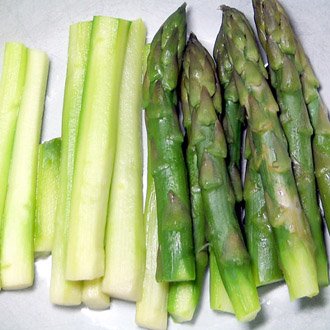 |
| Peeled asparagus stalks. (Photo courtesy: peter kaminski) |
While one may encounter asparagus year-round in supermarkets, its peak flavor is during springtime. In Europe, its shoots are available in shops from December to June.
Asparagus should be utilized promptly after harvesting to preserve its sweetness, as most of its sugar converts into starch over time. Opting to purchase from local farms or farmers' markets ensures freshness.
When selecting from the markets, opt for tender, firm, straight, smooth, uniformly-sized, dark green/purple stalks with tightly closed tips. Avoid thick stalks with broad ridges, sunken areas, or dull colors, as they indicate older stock and may be off-flavored.
Due to their perishable nature, asparagus should be harvested in the morning when the weather is cooler. After picking, immerse the spears in ice-cold water to remove heat, drain, and store them in plastic bags in the refrigerator set between 38 to 40 degrees F with 90% to 95% relative humidity. Higher temperatures can cause the spears to lose natural sugars and vitamin C, resulting in a loss of flavor, increased toughness, and decay.
Preparation and serving methods
 |
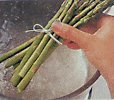 |
| The spears will snap where any woodiness begins. (Photo courtesy: The essential vegetarian cookbook). | Tie spears into a bundle. Cook for 2-3 minutes in boiling water with tips upward. Then just dip the tips briefly into the boiling water. |
Asparagus shoots are highly prized vegetables, especially during the spring season.
When cooking with fresh spears, it's preferable to wash them under cool running water with a gentle scrub. Tender, pencil-thin spears can be cooked as is, while thicker stalks should be peeled before use in recipes.
Typically, asparagus spears require only brief cooking. Some households use traditional pots, immersing the stalks in boiling water while allowing the tips to steam cook.
Here are some serving suggestions:
 |
| Bruschetta with asparagus, tomato, and cheese toppings. Photo courtesy: rizkapb |
Asparagus spears can be enjoyed raw, steamed, sautéed, stir-fried, or mixed with vegetables, beans, poultry, or seafood.
Steamed spears served with citrus hollandaise sauce, melted butter, parmesan, or pecorino cheese make beautiful French-style recipes.
Grilled spring onions and asparagus stalks, coated with macadamia nut oil, create a mouth-watering appetizer.
Stir-fry tender shoots with sesame seeds, and season with garlic, ginger, and pepper paste.
Many restaurants in Germany offer special spargel menus during the spring season.
Safety Profile
Overall, asparagus is well tolerated, and allergic reactions are relatively rare.
Ingestion of young shoots may cause an offensive smell in the urine. This is due to the metabolism of asparagusic acid, which breaks down into various sulfur-containing degradation products such as methanethiol, sulfides, etc. However, this condition is harmless. (Medical disclaimer).
≻≻- Back to Vegetables from Asparagus. Visit here for an impressive list of vegetables with complete illustrations of their nutrition facts and health benefits.
≻≻- Back to Home page.
Further reading:
Vegetable research and information center, University of California. (pdf-Link opens in new window).